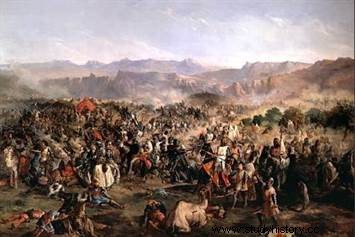 The Battle of Las Navas de Tolosa , July 16, 1212, is a decisive step for the success of the Reconquista of southern Spain by the Christian kingdoms. After a first phase which culminated in the capture of Toledo in 1085, the Reconquista had to stop in the face of the counter-offensive of the Almoravids from the battle of Zallaqa in 1086. It was not until the middle of the 12th century that the Christian kingdoms resume their march; but this time they encounter on their way another Berber dynasty, the Almohades. The defeat of the latter at Las Navas de Tolosa will open southern Spain to the Christian kings and cause the Almohad Empire to break up into short-lived small kingdoms of Taifas.
The Battle of Las Navas de Tolosa , July 16, 1212, is a decisive step for the success of the Reconquista of southern Spain by the Christian kingdoms. After a first phase which culminated in the capture of Toledo in 1085, the Reconquista had to stop in the face of the counter-offensive of the Almoravids from the battle of Zallaqa in 1086. It was not until the middle of the 12th century that the Christian kingdoms resume their march; but this time they encounter on their way another Berber dynasty, the Almohades. The defeat of the latter at Las Navas de Tolosa will open southern Spain to the Christian kings and cause the Almohad Empire to break up into short-lived small kingdoms of Taifas.
The Almohads before Las Navas de Tolosa
The latter succeed the Almoravids (whom they defeated in the Maghreb) with whom they share roughly the same origin and the same motivations. Their political and religious ideology is on the other hand original, with a universal vocation, and is based on the thought of a mahdi:Ibn Tûmart. His successors thus proclaim themselves caliphs, and affirm an even greater ambition than the Almoravids. But this doctrine precisely clashes with Malikite Sunnism, and also causes the failure to mobilize the Andalusian populations.
The Almohads took the place of the Almoravids in Al Andalus, eager to lead the jihad:they occupied Cordoba in 1148, Granada in 1154 and above all recaptured Almeria from the Christians in 1157. They attempted to impose, like the Almoravids, an ideology of Holy War, which culminates with the great victory of Alarcos in 1195. But yet these victories hide real difficulties, in particular in the face of increasingly united Christians. This will lead to the defeat of Las Navas de Tolosa.
Christians unite around the kings of Aragon and Castile
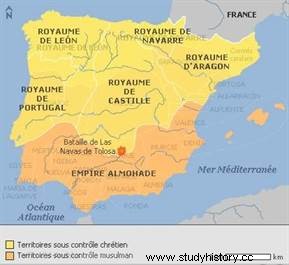 Since the capture of Toledo in 1085 there have been several attempts to unite the Christian kingdoms of the Iberian Peninsula . In 1109, Alfonso VI of Castile and Leon, without a male heir, entrusted his throne to his daughter Urraca, whose marriage he arranged with Alfonso I the Battler, King of Aragon. The result is a civil war, which leads to the withdrawal of Alfonso I (his marriage is annulled by the pope) and to the coming to power in Castile of Alfonso VII, son of Urraca (died in 1126) descended from his first marriage with Raymond of Burgundy. Like his grandfather, his ambitions are imperial and he manages to obtain the title from Alfonso I of Aragon. The latter died in 1134 without a successor, which caused a crisis in Navarre and Aragon...
Since the capture of Toledo in 1085 there have been several attempts to unite the Christian kingdoms of the Iberian Peninsula . In 1109, Alfonso VI of Castile and Leon, without a male heir, entrusted his throne to his daughter Urraca, whose marriage he arranged with Alfonso I the Battler, King of Aragon. The result is a civil war, which leads to the withdrawal of Alfonso I (his marriage is annulled by the pope) and to the coming to power in Castile of Alfonso VII, son of Urraca (died in 1126) descended from his first marriage with Raymond of Burgundy. Like his grandfather, his ambitions are imperial and he manages to obtain the title from Alfonso I of Aragon. The latter died in 1134 without a successor, which caused a crisis in Navarre and Aragon...
The next twenty years saw the attempts of Alfonso VII to establish his imperial power, thanks to the allegiance of the counts of Barcelona, Toulouse and then Navarre. This did not last long because of the intervention of the pope who demanded the application of the will of Alfonso I (his States had to be ceded to military religious orders to continue the crusade!). The situation is further complicated with the appearance at the same time of a new kingdom, that of Portugal, recognized by Alfonso VII. In 1139, Alfonso Henriquez was recognized as King of Portugal by the Pope.
The death of Alfonso VII in 1157 moved the lines, but not towards unity:his kingdom was divided between his two sons, Sancho and Ferdinand, the first receiving the Castile and the second Leon. However, despite this fragmentation, the ideal of Reconquista does not seem to have left the competing sovereigns.
A “crusade”?
If the Reconquista is an intangible objective for the various Spanish kings, it does not mean that they agree on the objectives and on their own possessions. Indeed, they dispute territories themselves:Leon and Portugal tear each other apart in southern Galicia and the Algarve; Aragon (united with Catalonia in 1150) and Castile, the left bank of the Ebro and the Kingdom of Murcia; Castile and Navarre, Rioja, Alava and Guipuzcoa. In addition, Castile also turned towards the North, with sights on Gascony following the marriage of Alfonso VIII with the daughter of Henry II Plantagenet. Wanting to have his rights recognized on these lands, the King of Castile approaches Philippe Auguste at the beginning of the 13th century, by marrying the latter's son, Louis, to his daughter Blanche (future mother of a certain Saint Louis). Finally, Portugal is threatened by Leon and Castile who want to carve it up and share it among themselves...
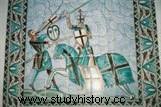 Fortunately, Castile and Aragon are much closer when it comes to pursuing the Reconquista. This only really restarted at the beginning of the 1170s, when the Spanish problems calmed down a bit, as did the difficulties of the Almohads in imposing themselves on a land where the Andalusians did not want them, as they did not. did not want the Almoravids. The conflict takes place mainly on the plateaus of the Tagus, without any real major confrontation but rather sieges of cities and castles.
Fortunately, Castile and Aragon are much closer when it comes to pursuing the Reconquista. This only really restarted at the beginning of the 1170s, when the Spanish problems calmed down a bit, as did the difficulties of the Almohads in imposing themselves on a land where the Andalusians did not want them, as they did not. did not want the Almoravids. The conflict takes place mainly on the plateaus of the Tagus, without any real major confrontation but rather sieges of cities and castles.
The religious military orders such as the Templars and the Hospitallers then took part, but above all the Spaniards created them themselves:the Order of Calatrava for example, which obtained the recognition of the Pope Alexander III in 1164. It is through this that we can compare the Reconquista with the crusade in the East, at this turn of the half of the 12th century:the sovereigns no longer had the monopoly of the struggle, they were "competed" by religious orders, clerics as important as Bernard of Clairvaux and his successors at Cîteaux, and by the popes. The Reconquista is no longer only temporal, but also spiritual.
The Almohads, a new threat
However, this is not enough! In 1195, the new Almohad caliph landed in Tarifa and crushed the armies of Alfonso VIII at the battle of Alarcos, a defeat comparable to that of Zallaqa in 1086, which slowed down the Reconquista so much. The Christians had to bend, first Sancho VII of Navarre and Alfonso IX of Leon, who agreed to pay tribute to the Almohades, then Alfonso VIII of Castile himself who signed a truce with Caliph al-Nasir. The conflict continues between Castile and Navarre…
Christians in fact owe their salvation only to the ambitions of the caliph who, intoxicated by his successes in Ifriqiya and the Balearic Islands (capture of Majorca in 1203), decides to resume the offensive in Al Andalus, and to break the truce. However, it took the mediation of the Archbishop of Toledo, Rodrigo Jimenez de Rada, for the Spanish kingdoms to make peace in 1208. The Order of Calatrava resisted more than fifty days against the Almohad armies in the fortress of Salvatierra, but the monks-warriors must finally surrender.
This is an opportunity for Alfonso VIII to raise a large Crusader army on the day of Pentecost in 1212:Castilians participate, but also armies from other countries Spanish kingdoms and French knights. The spirit of the fighters is then very religious, not only the will to defend a territory. Nevertheless, following the reconquest of the fortress of Calatrava on June 30, the French contingents reproach Alfonso VIII for having been too lenient with the Muslim prisoners, and decide to leave the army. This is then joined by other Spanish troops and heads towards Las Navas de Tolosa...
The battle of Las Navas de Tolosa and its aftermath
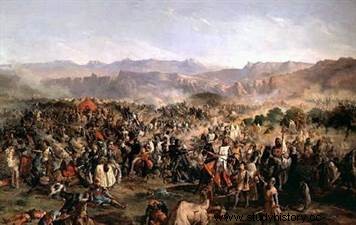
We do not immediately measure the impact of the Christian victory in Las Navas de Tolosa, but it caused a stir in the West. It was Alfonso VIII who emerged as the big winner on the Spanish side, while on the Almohad side it was the beginning of the erosion of power:in the following years, the caliphs even had to ask for help from the Christian sovereigns against their rivals in the Maghreb!
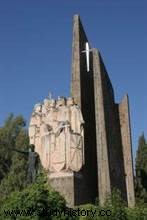 The Reconquista really picks up after several years, time for the Christian kingdoms to reorganize. The Almohads had to leave Al Andalus because of their problems in the Maghreb (against the Merinids for example), and the Christians had to face the emirs of the taifas who resisted for a time. But one by one the most important Andalusian cities fell:Cordoba in 1236, Seville in 1248, Cadiz in 1263,... In the end, only the Emirate of Granada, where the Nasrid dynasty settled in the 1230s, resisted the blows, and even took advantage of new rivalries between Christian kingdoms to resist until…1492!
The Reconquista really picks up after several years, time for the Christian kingdoms to reorganize. The Almohads had to leave Al Andalus because of their problems in the Maghreb (against the Merinids for example), and the Christians had to face the emirs of the taifas who resisted for a time. But one by one the most important Andalusian cities fell:Cordoba in 1236, Seville in 1248, Cadiz in 1263,... In the end, only the Emirate of Granada, where the Nasrid dynasty settled in the 1230s, resisted the blows, and even took advantage of new rivalries between Christian kingdoms to resist until…1492!
This does not prevent the fact that the battle of Las Navas de Tolosa is a key date of the Reconquista, since it really marks the halt and even the reflux of the Muslims in Andalusian land. Moreover, it is symbolic of the religious spirit, which some call the spirit of crusade, which marked the Reconquista from the second half of the 12th century.
Bibliography
- D. MENJOT, Medieval Spains (409-1474), Hachette, 2006.
- Grandes Heures du Beau XIIème Siecle:From Hastings to Bouvines via Canossa, Constantinople and Las Navas de Tolosa by Jean-Jacques Tijet. 2008.
- The Bloodiest Battles in History, Famot, 1997.
